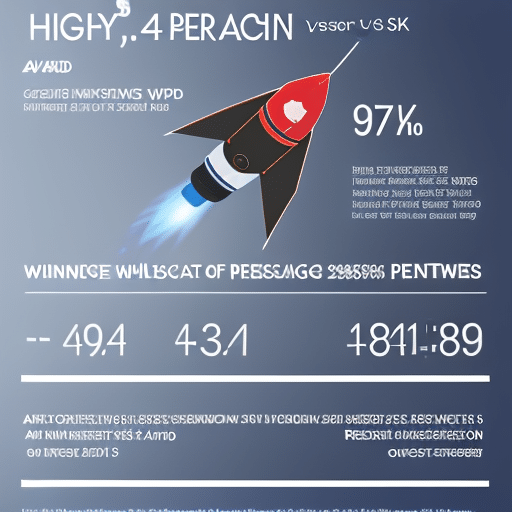Defi Risk Management
Decentralized finance, or DeFi for short, is an emerging financial system that operates entirely on blockchain-based networks. It enables users to access a wide range of financial services such as lending, borrowing and trading without the need for traditional intermediaries like banks and brokers. As DeFi continues to grow in popularity, it is becoming increasingly important to understand the risks involved and how best to manage them. This article will explore the types of risk associated with DeFi projects, methods for identifying these risks and strategies for mitigating them. Furthermore, this article will discuss techniques for managing liquidity risk, cyber security considerations and regulatory compliance issues. Finally, it will consider insurance as a means of protecting against certain risks related to DeFi projects.
Overview of DeFi
DeFi, or Decentralized Finance, is a rapidly growing sector of the financial technology landscape with over $6 billion in locked assets as of March 2021. In DeFi applications, smart contract auditing plays an important role in ensuring security since these are open-source applications and can be accessed by anyone. Price volatility is also a major risk that must be taken into account when engaging in DeFi activities. As such, it is important to understand the different types of risks associated with DeFi before engaging in any activity within this space.
Types of Risk
Risk in decentralized finance (DeFi) can take many forms. Market Risk is the risk of a drop in asset prices due to market conditions. Liquidity Risk relates to the ability of traders to easily and promptly convert assets into cash. Counterparty Risk is associated with the potential for counterparties to not fulfill their contractual obligations. Regulatory Risk refers to uncertainty about future regulations which could affect DeFi projects. Smart Contract Risk includes the possibility of coding bugs or vulnerabilities leading to financial losses for users.
Market Risk
Investors in decentralized finance must be aware of the potential market risk associated with their investments. Market risk is a type of risk that affects all investments, and it is caused by fluctuations in the prices of financial instruments or assets. Price volatility and margin trading are two major components of market risk investors should consider when investing in defi.
Price volatility refers to sharp price movements either up or down within a short period of time which can lead to significant losses for investors if they do not adequately protect themselves from such risks. Margin trading involves borrowing money from brokers or other lenders to amplify returns but also magnifies losses due to its higher leverage levels. It is important for investors to understand these risks before engaging in margin trading activities on decentralized exchanges. With this knowledge, investors can better manage their funds and reduce the chances of suffering large losses due to market risks. This leads into the subsequent section about liquidity risk, an important aspect of defi risk management that requires further consideration.
Liquidity Risk
When investing in decentralized finance, liquidity risk is an ever-present concern that must be carefully considered; like a wave crashing against a shoreline, it can quickly erode the profits of unwitting investors. To mitigate this risk, defi protocols often pool liquidity from multiple sources to provide sufficient capital for transactions and borrowing. This also allows for collateral requirements which help to ensure that the funds being invested are backed by reliable assets. Additionally, these requirements can help prevent users from taking on too much leverage and putting their investments at undue risk. As such, liquidity pooling and collateral requirements offer an important layer of protection when investing in decentralized finance platforms. However, there is still the potential for counterparty risk if one or more investors fail to meet their obligations.
Counterparty Risk
Despite the protective measures in place, decentralized finance investments can still be vulnerable to counterparty risk if investors fail to meet their obligations. Counterparty risk is a type of financial risk that arises from one party’s failure to fulfill its contractual obligations and is associated with trade finance activities such as deposits, payments, loans, and other transactions. In decentralized finance (DeFi), potential counterparty risk exists due to the reliance on third-party services like liquidity pools or exchanges. As such, DeFi users must consider the possible risks associated with:
- Liquidity pools: The use of liquidity pools poses a threat of insolvency when users are unable to redeem their funds due to lack of liquidity in the pool or mismanagement by the operator.
- Exchange platforms: Cryptocurrency exchange platforms could become insolvent leading to loss of funds for those who have deposited cryptocurrency into their accounts or purchased digital assets through them.
- Smart contracts: Smart contract bugs may also lead to exploitation resulting in losses for users engaging with affected protocols or smart contracts.
Considering these risks, it is essential that DeFi users do proper research before investing and stay informed about any changes in order mitigate counterparty risk exposure. In light of this, regulatory oversight becomes an important factor when assessing the safety of investments from a broader perspective in terms of regulatory risk.
Regulatory Risk
Regulatory risk is an important consideration for decentralized finance investments, as varying levels of oversight can affect the viability and safety of these assets. For example, a lack of uniform regulations across countries may lead to conflicts between different laws and standards, creating potential legal liabilities for investors. Therefore, it is essential that investors undertake thorough risk assessment prior to investing in DeFi products to ensure that they are compliant with all applicable laws and regulations. This includes understanding how the asset is structured, the underlying technology used, and any associated regulatory risks that could arise in different jurisdictions. Smart contract risk is another critical element which must be taken into account when investing in DeFi products.
Smart Contract Risk
Smart contract risk is a major consideration for any DeFi project. Smart contracts are automated, self-executing computer programs used to facilitate transactions on the blockchain network. As such, they can be subject to errors and bugs that could lead to significant losses for users. Therefore, it is important to conduct code audits of smart contracts prior to deployment in order to identify potential issues and determine the best way forward. In addition, smart contracts should be tested using testnets or simulators before being deployed on mainnet in order to ensure their functionality and consistency with expected outcomes. Doing so can help reduce risks associated with automation, as well as helping identify any issues that may arise from incorrect coding or syntax errors. With this knowledge in hand, teams should then move onto identifying other risks associated with DeFi projects such as regulatory risk and liquidity risk in order to create a comprehensive plan for reducing their exposure.
Identifying Risks
Researching the project, monitoring market conditions, and evaluating counterparty creditworthiness are all important aspects of identifying risks. Understanding the underlying factors that could affect a given project or investment is key in determining potential risks. Both internal and external sources must be monitored to ensure an accurate assessment of potential risk; this includes researching the project itself, tracking changes in markets that may impact investments, and evaluating a counterparty’s creditworthiness before entering into any agreement with them.
Researching the Project
Analyzing the project is a crucial step in risk management for DeFi protocols. It requires an understanding of the protocols’ underlying technology, how it works, and its key features. Additionally, diversification strategies should be implemented to spread risk across multiple projects or asset classes. Automated trading can also help investors reduce their exposure to market volatility by executing trades at predetermined prices and times without having to actively monitor markets. Furthermore, research into the team behind the project can provide insight into its potential success and longevity, as well as any red flags that could signal future issues. Understanding these components helps investors make informed decisions regarding whether or not they want to add a particular asset or protocol to their portfolio. Monitoring market conditions is another important step in DeFi risk management in order to stay abreast of changing prices and other developments that might affect investments.
Monitoring Market Conditions
After thoroughly researching the project, it is essential to monitor market conditions to assess and manage risks associated with DeFi investments. Sentiment analysis is an important tool used to measure investor sentiment, which can be used as a risk indicator for DeFi projects. Additionally, risk scoring models can help rank and prioritize potential risks by assigning scores based on their severity.
To further evaluate the associated risks of a DeFi investment, it is necessary to assess counterparty creditworthiness. This includes evaluating the participants involved in a transaction as well as any third parties who may have an influence on the outcome. By doing this, investors can better understand all risks associated with their investments and take steps to protect them from harm.
Evaluating Counterparty Creditworthiness
Assessing the creditworthiness of counterparties is an important step in evaluating any potential DeFi investments. The process involves an assessment of the counterparty’s credit score, which is a measure of their ability to honor their debt obligations. It also involves assessing the collateralized debt that may be available if repayment is not made and whether it is sufficient to cover any losses. Credit scoring allows investors to determine if a counterparty has sufficient resources to service their debts and can provide an indication of future performance. Additionally, it helps identify risks associated with certain counterparts such as fraud or default on payments. Evaluating counterparty creditworthiness provides investors with peace of mind when making DeFi investments and helps mitigate risk by allowing them to make better informed decisions. To further protect against investment loss, it is important for investors to consider other methods for mitigating risks such as diversification strategies and hedging techniques.
Mitigating Risks
Identifying, mitigating, and monitoring risks are essential for successful DeFi risk management. Risk management in the decentralized finance (DeFi) space can be accomplished through diversifying investments, hedging strategies, ensuring liquidity, and implementing proper security protocols.
Diversifying investments is a key component to risk mitigation. By spreading capital across multiple platforms or tokens that have an inverse relationship with one another, investors can reduce their exposure to a single asset class or token. Additionally, utilizing hedging strategies can help protect against sudden price movements and ensure long-term profitability. Ensuring adequate liquidity is also important for reducing costs associated with trading and managing assets on the network. Last but not least, it is critical to implement proper security protocols such as multi-signature wallets into any DeFi project to protect against malicious actors or hackers attempting to exploit vulnerabilities within the codebase.
By taking these steps into account during the development of any DeFi application or protocol, users will be better able to manage their risk profiles when engaging in decentralized finance activities.
Managing Liquidity Risk
Liquidity risk is an important factor to consider when engaging in cryptocurrency trading. Exchange or protocol selection can be a critical decision, as different exchanges and protocols support different levels of liquidity. Furthermore, market making strategies can be employed to improve liquidity and reduce the likelihood of slippage during high volatility periods.
Choosing the Right Exchange or Protocol
Navigating the complex digital landscape of decentralized finance (DeFi) requires careful consideration when choosing an exchange or protocol. It is important for investors to take time to evaluate potential exchanges and protocols based on their project research and market analysis. This includes carefully examining: 1) exchange fees, 2) security measures, 3) liquidity levels, 4) user interface. All of these factors should be taken into account in order to make an informed decision regarding which exchange or protocol best meets the individual’s needs. Additionally, it is important to stay abreast of the DeFi space by keeping up with new developments and innovations that may be beneficial to a particular investor. With this information in hand, investors can then move forward with utilizing market making strategies that are tailored to their risk profile and investment goals.
Utilizing Market Making Strategies
Adopting market making strategies can enable investors to capitalize on the ever-evolving DeFi landscape and enjoy potentially lucrative returns. Diversification strategies, hedging approaches, and arbitrage opportunities are all important tools that should be employed when attempting to maximize profits and reduce risk in the increasingly complex DeFi sector. Market makers play a vital role in providing liquidity for digital assets by supplying capital and actively trading digital tokens. By utilizing these market making techniques, investors can spread their holdings across different protocols and exchanges to mitigate risk, while also taking advantage of potential arbitrage opportunities as prices fluctuate between platforms. As such, market making is an effective way for DeFi users to reduce their risks while still enjoying potential profit gains from participating in the decentralized finance space. To ensure optimal safety and security of funds within this environment however, it is essential that users employ robust cybersecurity measures too.
Cybersecurity
Securing digital assets from malicious attacks is an essential component of effective DeFi risk management. Data privacy and network security are two key elements to consider when implementing a strong cybersecurity protocol for DeFi platforms. Hackers can use various techniques, like phishing scams or malware downloads, to access user information or disrupt the functioning of a platform’s smart contracts. Having adequate encryption protocols in place to protect data, as well as robust firewall systems on the network can help prevent these kinds of attacks from occurring. Additionally, regular audits should be conducted by independent third-parties to detect any potential vulnerabilities in user accounts or platform infrastructure before they are exploited by hackers.
To ensure successful DeFi risk management strategies, it is important that regulatory compliance is also taken into consideration. Regulatory agencies have established guidelines for digital asset providers and exchanges that must be followed in order to protect users’ safety and financial interests. Failing to comply with these regulations can result in fines or other legal action against the organization responsible for managing the platform’s operations. As such, it is essential that businesses understand their obligations under existing laws and take steps accordingly to stay compliant with all applicable regulations.
Regulatory Compliance
Maintaining regulatory compliance is a critical factor for digital asset providers and exchanges to ensure user safety and financial security. It is essential that these businesses adhere to applicable laws, regulations, and licensing requirements in order to conduct their operations lawfully. Regulatory compliance also involves understanding the legal implications of data privacy for customer information, as well as having processes in place that comply with local laws governing digital assets such as cryptocurrencies. Compliance with regulations helps protect customers from fraud or other criminal activities while providing them with assurances about the legitimacy of their transactions and investments. By adhering to proper regulatory protocols, businesses can establish trust among users by demonstrating commitment to compliant practices. As such, it is vital that companies take every necessary step to ensure they are meeting all relevant standards when it comes to regulatory compliance for defi risk management. To further reduce risk levels, insurance policies can be employed as an additional safeguard against potential losses or liabilities.
Insurance
Incorporating insurance policies into a digital asset provider or exchange’s operations can provide an additional layer of protection from potential losses or liabilities. Risk assessment is the key factor to consider when incorporating insurance into DeFi risk management, as its purpose is to identify and measure potential risks that could affect the organization’s assets and operations. This process includes analyzing potential risks, understanding their possible implications, and developing strategies for addressing them. Insurance can also help reduce compliance costs by providing coverage for regulatory penalties that may be imposed if certain laws are not adhered to. Furthermore, it may also cover legal expenses incurred in defending any claims brought against the organization due to non-compliance with applicable regulations. Insurance policies should be tailored specifically to each particular organization’s needs in order to ensure optimal protection against losses associated with DeFi activities.






 Bitcoin
Bitcoin  Ethereum
Ethereum  Tether
Tether  XRP
XRP  Solana
Solana  USDC
USDC  TRON
TRON  Dogecoin
Dogecoin  Lido Staked Ether
Lido Staked Ether  Cardano
Cardano  Wrapped Bitcoin
Wrapped Bitcoin  Hyperliquid
Hyperliquid  Wrapped stETH
Wrapped stETH  Sui
Sui  Bitcoin Cash
Bitcoin Cash  Chainlink
Chainlink  LEO Token
LEO Token  Stellar
Stellar  Avalanche
Avalanche  USDS
USDS  Wrapped eETH
Wrapped eETH  Shiba Inu
Shiba Inu  Toncoin
Toncoin  Hedera
Hedera  WETH
WETH  Litecoin
Litecoin  WhiteBIT Coin
WhiteBIT Coin  Binance Bridged USDT (BNB Smart Chain)
Binance Bridged USDT (BNB Smart Chain)  Monero
Monero  Coinbase Wrapped BTC
Coinbase Wrapped BTC  Ethena USDe
Ethena USDe  Polkadot
Polkadot  Bitget Token
Bitget Token  Uniswap
Uniswap  Aave
Aave  Pepe
Pepe  Dai
Dai  Pi Network
Pi Network  Ethena Staked USDe
Ethena Staked USDe  Bittensor
Bittensor  Cronos
Cronos  Aptos
Aptos  OKB
OKB  BlackRock USD Institutional Digital Liquidity Fund
BlackRock USD Institutional Digital Liquidity Fund  NEAR Protocol
NEAR Protocol  Jito Staked SOL
Jito Staked SOL  Internet Computer
Internet Computer  Ethereum Classic
Ethereum Classic  Ondo
Ondo